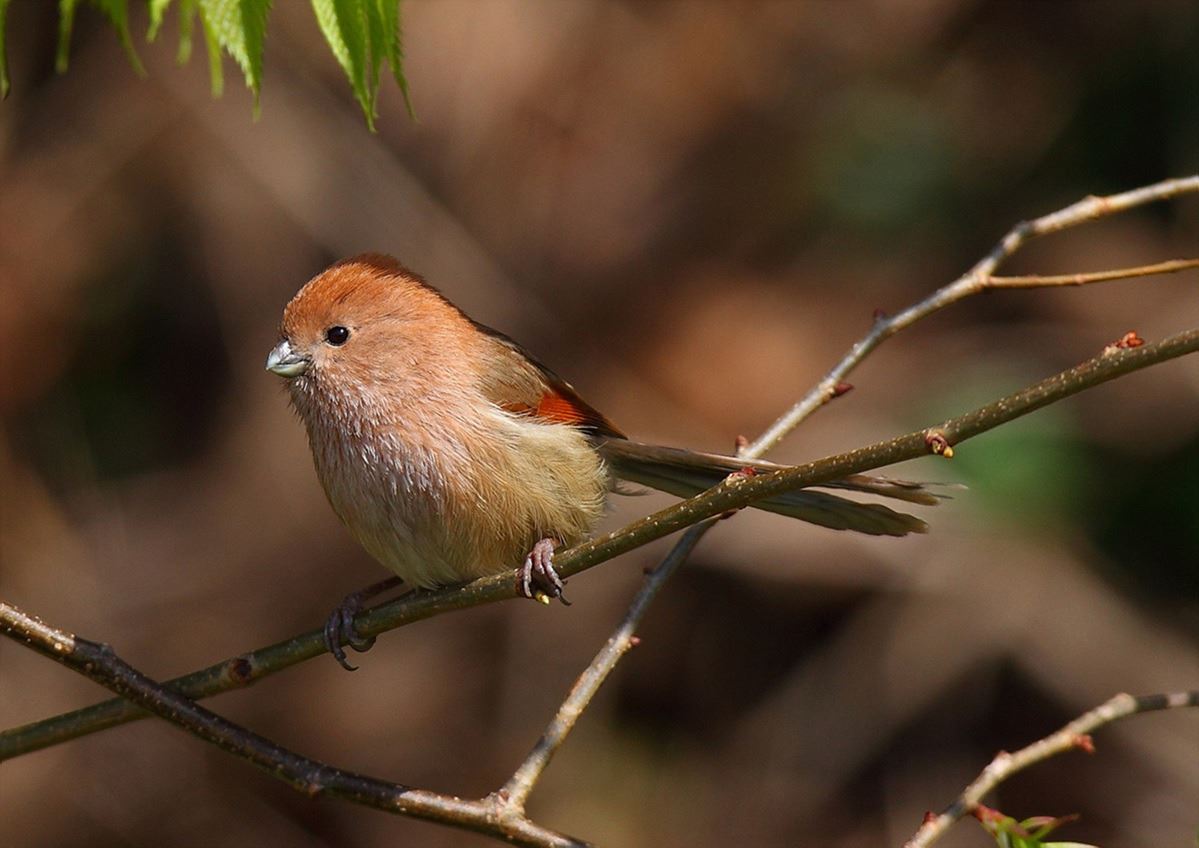| 붉은머리오목눈이 (Sinosuthora webbiana) | |
|---|---|
| 목(目) | 참새목 Passeriformes |
| 과(科) | 흰턱딱새과 Sylviidae |
| 속(屬) | 붉은머리오목눈이속 Sinosuthora |
| 종(種) | 붉은머리오목눈이 S. webbiana |
| Vinous-throated parrotbill (Sinosuthora webbiana) | |
|---|---|
| Order | Passeriformes |
| Family | Sylviidae |
| Genus | Sinosuthora |
| Species | S. webbiana |

뱁새(문화어: 부비새, 비비새) 또는 붉은머리오목눈이(Sinosuthora webbiana)는 한반도와 중국, 일본, 몽골, 러시아, 태국, 그리고 베트남에 서식하는 연작류이다.
The vinous-throated parrotbill (Sinosuthora webbiana) is a species of parrotbill in the family Sylviidae; formerly, it was placed in the closely related Timaliidae. It is found in China, Japan, Korea, Mongolia, Russia, Taiwan, and Vietnam.
오목눈이와는 다른 분류군에 속한다. 이전에는 '붉은머리오목눈이과'라는 독자적인 분류군을 형성했으나 현재는 흰턱딱새과에 통합되었다.
The vinous-throated parrotbill was described in 1852 by John Gould and placed in the genus Suthora, where it sat with other small browner parrotbills. Later parrotbills were merged into two genera, Conostoma and Paradoxornis; with this species being placed in Paradoxornis. Recent DNA studies have shown that the genus Paradoxornis is paraphyletic, and that it should be split. It is suggested that the vinous-throated parrotbill should be placed in the genus Sinoparadoxornis. The vinous-throated parrotbill is very closely related to the ashy-throated parrotbill, and hybrids have been reported between the two species in Vietnam and China, as well as in Italy where both species have become established. The specific name webbiana commemorates the English botanist Philip Barker Webb. The species is sometimes referred to as Webb's parrotbill.
붉은머리오목눈이(뱁새)
Vinous-throated parrotbill
자연 서식지는 아열대나 열대의 습한 산림이다. 윗쪽은 연한 갈색이고 아랫쪽은 진한 갈색이라 약간 차이가 있다. 암컷은 수컷보다 색이 연하다. 참새와 크기와 색깔이 비슷해서 대충 보면 참새인 줄로 알지만, 잘 살피면 금방 참새와 구분할 수 있다. 일단 참새보다 덜 시끄럽고 좀 더 동그라다 싶으면 뱁새다.
Its natural habitat is subtropical or tropical moist montane forests. It has light brown feathers on top and darker brown feathers on the lower side. Female Vinous-throated parrotbills have lighter colored feathers.
동작이 재빠르고 움직일 때 긴 꽁지를 좌우로 흔드는 버릇이 있다. 덤불,
갈대밭, 관목, 잡초가 자라는 지역에서 여러 마리가 무리지어 휘파람
소리를 내며 질서 있게 움직인다.
천적
Survival
뻐꾸기에겐 좋은 둥지셔틀이기도 하다. (#새 탭에서 비디오 링크 열기) 과학소년에서도 한때 아예 붉은머리오목눈이에게 탁란을 한 뻐꾸기로 기사를 썼을 정도. 그런데 이를 알고 대처하는 개체도 있다. 뻐꾸기가 자신의 둥지에 탁란할 줄 아는 뱁새는 둥지를 정성껏 지은 후 고의로 무정란을 낳는다. 무정란 옆에 뻐꾸기가 알을 낳으면 이런 개체가 돌아와 뻐꾸기알을 부숴버린 후 둥지를 버리고 다른 곳으로 간다.
Vinous-throated parrotbills often become a target of brood parasitism. Cuckoos lay eggs in the nest of the parrotbills. Some of the brown birds notice that cuckoos are around and lay unfertilized eggs. Once a cuckoo parasitize, the parrotbill breaks the suspicious egg and fly away to find another place to build a new nest. However, in many cases, a cuckoo chick gets to hatch and push the step-siblings out of the nest. (#video link in a new tab) It can do that because of it's special shape of the back.
뱁새가 낳는 알은 푸른색과 하얀색이 있는데, 이와 전혀 다른 색의 알을 낳는 새는 드물다. 색깔은 암컷의 유전자에 따라 정해진다. 하얀색의 알을 낳는 암컷은 계속 하얀 알을 낳고, 푸른색의 알을 낳는 암컷은 푸른 알을 낳는 것이다. 하얀 알과 푸른 알의 비율은 지역에 따라 조금씩 차이가 있지만 보통 70~80%가 푸른색 알을 낳는다. 하얀 알을 낳는 경우는 푸른 알을 낳는 뻐꾸기와 관계가 있다고 보기도 한다. 색이 다르면 뻐꾸기가 탁란을 했음을 알아차리기도 한다. 그 외에 다른 천적은 알을 먹는 어치 · 누룩뱀 등이 있다.
한국의 뱁새
In Korea
한국에서 발견되는 둥지는 개나리, 국수나무, 찔레나무, 쥐똥나무, 사철나무, 조릿대 등 키가 작은 나무에 지푸라기와 죽은 잡목의 나무 껍질들을 거미줄로 연결해서 밥그릇 모양으로 만들어져 있다. 붉은머리오목눈이의 둥지는 비바람에 무너지지 않을 만큼 튼튼하다. 덤불숲에 있어서 비에 둥지가 완전히 젖지 않으며, 보통 4월~7월 사이에 4~6개의 알을 낳아 번식한다.
Their nest found in Korea tend to be made with straws and barks in a shape of a bowl. The birds sitck the materials together with spider web. They build their home in short trees and bushes such as forsythia, laceshrub, wild rosebush, privet, spindle tree, and northern bamboo. The nests are sturdy enough to endure storm. The little brown bird typically lays 4 to six eggs during spring.
겨울에는 거의 항상 같은 종끼리 떼를 지어 다니며 덤불이나 키가 큰 풀 사이에 단체로 숨기를 좋아한다. 사람이 가까이 가면 단체로 숨느라 난리법석. 또,나뭇가지 사이에서 이동할 때는 징검다리 건너듯이 가지를 하나하나 밟으며 이동한다.
They fly in groups especially in winter, flying from a bush to another and hide. They would hide into bushes making a fuss if anyone would approach. Also, the bird jumps between branches like walking on stepping stones when it flies inside bushes.
한국에선 참새만큼 흔해서, 19개 공원에서 무려 2만 마리 이상이 발견되었다고 한다. 전국적으로는 훨씬 많을 것이다.
그만큼 흔해서 그런지, '뱁새가 황새 따라가다 가랑이 찢어진다.'는 속담에도 등장한다. 오늘날 황새의 개체수가 급격하게 줄어 멸종위기종과 천연기념물로 지정된 귀한 새가 되었지만, 붉은머리오목눈이는 아직도 우리 근처 가까운 곳에서 과거와 동일하게 소란스럽지만 귀여운 새로 남아있다.
They are called "Bepsae" and are very common birds in Korea. They even appear on an old saying that goes like this. "A Bepsae tries to walk like a stork breaks it's leg". Number of storks in Korea is rapidly reduced and now it is selected to be one of endangered species. However Vinous-throated parrotbills are still flying around Korea making little fusses.
황새에게 비교당하고 뻐꾸기에게 치이고 사는 대한민국의 모든 뱁새에게 이 페이지를 바친다. 힘내라. 강한 자가 살아남는 게 아니라, 살아남는 자가 강한 것이다.
This page is dedicated to all the Vinous-throated parrotbills that are being comapred to Oriental storks and are struggling with cuckoos. Cheer up! The strong does not survive, the survivor is strong.
관련링크
References

